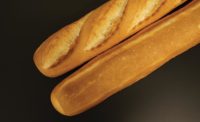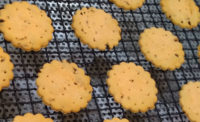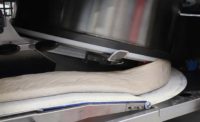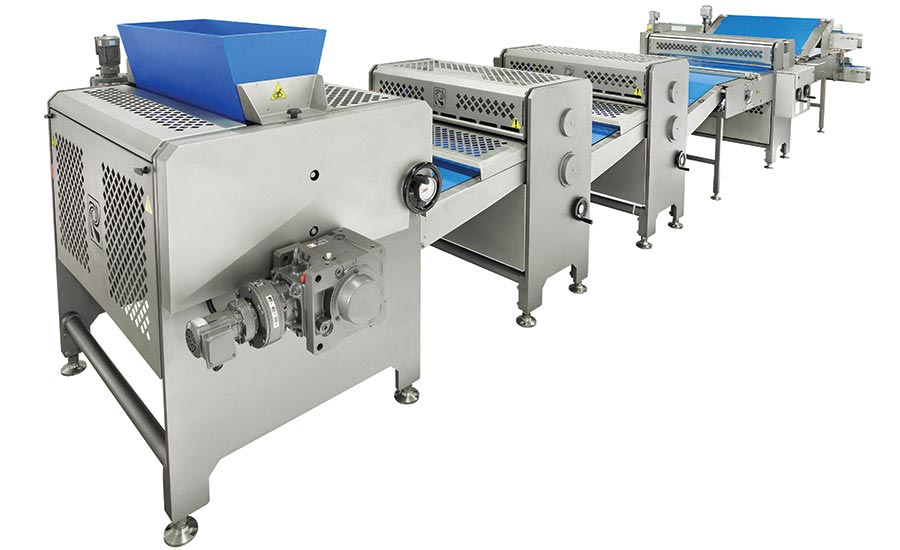New designs that allow for flexible width, more compact production space, easier cleaning and better sanitation, all while featuring more technologically advanced controls, have been foremost on the minds of snack and bakery companies in recent months and years when replacing or upgrading their sheeters and laminators.
Key features
The Flex Divider VX 731 from Rheon USA, Irvine, CA, provides the ability to lay different dough widths at the very start of the line, says John Giacoio, national sales director. This isn’t so important for laminated doughs, but does make a difference on an artisan bread line. “It allows us to put down a dough sheet that is more in keeping with the product being made down line,” he says. “That innovation allows us to reduce the amount of side trim, thereby improving the quality, with that much less scrap.”
Previously, Giacoio says, Rheon offered different models at different widths but they did not have the flexibility to shift those widths as products evolved. “We use that machine with any sheeting line,” he says.
The machine also improves line efficiency because it’s not an easy machine to slide in and out—it has to be integrated with the rest of the line—so it’s something you have to install and leave installed, which the flex-divider allows, Giacoio says.
proBAKE, Twinsburg, OH, has produced a flexible, two-in-one solution for customers producing harder biscuits like Danish butter cookies, says Tyler Wallace, vice president. Where producers used to need to run rotary cutters and molders separately, and switch them in and out as necessary, the new Polin RTV combination system does both.
“Space is always an issue—spatial limitations and budget,” he says. “This is designed for a specific group of customers where budget and spatial issues is a deciding factor … we’re definitely taking up less space because you don’t need two separate feeding systems for the dough. In terms of efficiencies, you have one common point, not feeding two separate areas. It streamlines the process when the customer has that need.”
New Cracker Production System designs from Reading Bakery Systems, Robesonia, PA, incorporate tighter feed system controls to ensure more-accurate side to side weight variation, “while at the same time ensuring that the proper amount of energy is being applied when reducing the sheet thickness,” says Shawn Moye, vice president of sales. “This allows better dough density control across the entire sheet width.”
Reading’s cracker production line can be integrated into sheeting lines, replacing existing sheeters, laminators, gauge roll stations, rotary cutters, application conveyors and oven infeed conveyors, Moye says. The company also offers electrical controls upgrades to existing forming lines, he says.
Washdown and maintenance
Washdown and maintenance are other key considerations. An upgrade of the Sigma laminator and new universal makeup table design are the new offerings from Rademaker USA, Hudson, OH. The Sigma 2.0, which incorporates butter into the dough for croissants and Danishes, was designed with sanitation and washdown in mind, with a program that allows the line to be cleaned during production, notes Eric Riggle, vice president.
“We sloped the surfaces so that water doesn’t build up and doesn’t accumulate, but is easily drained off,” he says. “From a maintenance perspective, when things are easier to clean, they’re easier to maintain … a lot of our machines can be maintained on the fly. There’s critical maintenance functions that can be done while lines are functioning. Our belts and rollers are constantly scraped clean during production so you don’t have to do it by hand. That allows you to run faster and more efficiently.”
Similarly, the universal table incorporates easier cleaning, sloped covers and a lack of “dead ends” where water can build up and accumulate, Riggle says. “It’s all about time being money,” he says. “When our clients are spending time cleaning a machine, or changing a machine, they’re not selling a product for money.”
The ASTec Laminating Line from RONDO, Burgdorf, Switzerland, produces puff pastry, Danish dough and croissant dough, and has been continuously improved to meets growing hygiene requirements, says Jörg Sonnabend, manager of marketing communications.
“High-quality, food-safe materials have been chosen to ensure rapid and efficient cleaning,” says Sonnabend. “Niches and horizontal surfaces have been avoided to mitigate accumulation of product scraps or materials in niches of cavities. All components for cleaning are easy to access without the use of tools.”
RONDO designed the line based on the Grocery Manufacturers Association’s 10 principles for a high standard of hygiene, Sonnabend says. These cover issues like cleaning methods, sealed cavities, lack of niches, easy accessibility to all system sections and separated work processes to avoid cross-contamination (see www.gmaonline.org/forms/store/ProductFormPublic/equipment-design-checklist-for-low-moisture-foods).
The Cracker Production System from Reading has been optimized to meet the new Food Safety Modernization Act standards for sanitation and safety, Moye says. “Our belief is that what is seen is cleaned and maintained,” he says. “We guard only what is necessary to avoid creating potential harborages, uncleanable areas and allow operations and maintenance to have a comprehensive view of the equipment at all times, not just during shutdown periods.”
Total washdown isn’t always the goal, though. “The more I talk with customers, the more I hear that they don’t necessarily want to wash these things down,” Giacoio says. “They’re looking for something that’s designed well so they can clean it easier. With every generation, we’re trying to increase the ability to sanitize and clean equipment. It’s easier to access the panels without tools; you can just pop things off and clean them.”
State-of-the-art controls
Control systems continue to grow more intuitive. RONDO also offers the RONDOnet multi-platform control system that provides entry into the Internet of things for the purposes of supervising line and production processes, storing events on the production line, detecting error states, analyzing recorded history, identifying and controlling user interactions, and providing user support for maintenance and documentation.
“The production manager has direct access to the parameters of the line and the process,” Sonnabend says. “The analysis of the history allows us to optimize the production … the entry into the Internet of things is a great new tool to minimize downtime and to optimize the performance of the line.”
Rademaker’s equipment comes with a product tooling assistant in which the user selects, for example, a 4-ounce cinnamon roll, and the coded tooling matches what’s on the screen and tells the operator where each tool needs to be on the conveyor, Riggle says.
“They know tool 12345 goes into position 1,” he says. “It can only go in one way, and they can’t mess it up, put it in backwards or upside down. The tooling is easier to remove, more lightweight but still robust. It’s easier to take on and off the line. We took the time to make these lines as foolproof as we could.”




















